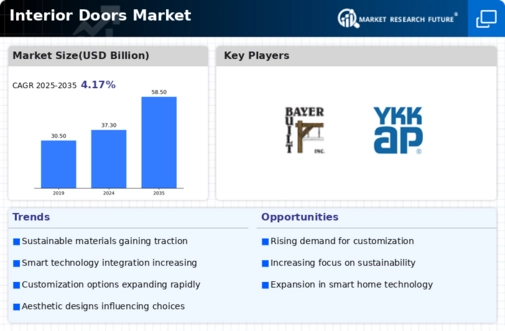-
Executive Summary
-
2
-
Scope of the Report
-
Market Definition
- Definition
- Assumptions
-
2.2
-
Scope of the Study
-
2.2.2
-
Research Objective
-
2.2.4
-
Limitations
-
Research Process
- Secondary Research
-
2.3.1
-
Primary Research
-
2.4
-
Market size Estimation
-
Forecast Model
-
3
-
Market Landscape
-
Porter’s Five Forces Analysis
- Threat of New Entrants
- Bargaining
- Threat of substitutes
- Bargaining Power of Buyers
-
power of buyers
-
3.1.4
-
Segment rivalry
-
Value Chain/Supply Chain Analysis
-
Market
-
Dynamics
-
Introduction
-
Market
-
Drivers
-
Market Restraints
-
Market
-
Opportunities
-
Global Interior Doors Market, By Door Type
-
Introduction
-
Panel Door
- Market
-
5.2.1
-
Market Estimates & Forecast, 2020-2027
-
Estimates & Forecast by Region, 2020-2027
-
Bypass
- Market Estimates & Forecast, 2020-2027
- Market Estimates & Forecast by Region, 2020-2027
-
Door
-
Bifold Door
- Market Estimates
- Market Estimates & Forecast
-
& Forecast, 2020-2027
-
by Region, 2020-2027
-
Pocket Door
- Market
-
5.5.1
-
Market Estimates & Forecast, 2020-2027
-
Estimates & Forecast by Region, 2020-2027
-
Others
- Market Estimates & Forecast, 2020-2027
-
5.6.2
-
Market Estimates & Forecast by Region, 2020-2027
-
Global
-
Interior Doors Market, By Material
-
Introduction
- Market Estimates & Forecast, 2020-2027
- Market Estimates & Forecast by Region, 2020-2027
-
6.2
-
Wood
-
Glass
- Market Estimates &
- Market Estimates & Forecast
-
Forecast, 2020-2027
-
by Region, 2020-2027
-
Metal
- Market
-
6.4.1
-
Market Estimates & Forecast, 2020-2027
-
Estimates & Forecast by Region, 2020-2027
-
Fiberglass
- Market Estimates & Forecast, 2020-2027
- Market Estimates & Forecast, 2020-2027
- Market Estimates & Forecast by Region, 2020-2027
-
6.5.2
-
Market Estimates & Forecast by Region, 2020-2027
-
6.6
-
Fiberboard
-
Vinyl
- Market Estimates &
- Market Estimates & Forecast
-
Forecast, 2020-2027
-
by Region, 2020-2027
-
Others
- Market
- Market Estimates
-
Estimates & Forecast, 2020-2027
-
& Forecast by Region, 2020-2027
-
Global Interior Doors
-
Market, By End-user
-
Introduction
- Market Estimates & Forecast,
- Market Estimates & Forecast by Region,
-
7.2
-
Residential
-
Commercial
- Market
- Market Estimates
-
Estimates & Forecast, 2020-2027
-
& Forecast by Region, 2020-2027
-
Industrial
- Market
-
7.4.1
-
Market Estimates & Forecast, 2020-2027
-
Estimates & Forecast by Region, 2020-2027
-
Global Interior
-
Doors Market, By Region
-
Introduction
- Market Estimates & Forecast,
- Market Estimates & Forecast by Door Type,
- US
- Canada
- Mexico
- Market Estimates & Forecast, 2020-2027
- Market Estimates & Forecast by Door Type, 2020-2027
- UK
- Germany
- France
- Rest of Europe
-
8.2
-
North America
-
Estimates & Forecast, 2020-2027
-
& Forecast by Door Type, 2020-2027
-
8.2.4.1
-
Market Estimates & Forecast, 2020-2027
-
Estimates & Forecast by Door Type, 2020-2027
-
8.2.5.2
-
Market Estimates & Forecast by Door Type, 2020-2027
-
8.3
-
Europe
-
Forecast, 2020-2027
-
by Door Type, 2020-2027
-
8.3.4.1
-
Market Estimates & Forecast, 2020-2027
-
Estimates & Forecast by Door Type, 2020-2027
-
8.3.5.2
-
Market Estimates & Forecast by Door Type, 2020-2027
-
8.3.6
-
Italy
-
& Forecast, 2020-2027
-
Forecast by Door Type, 2020-2027
-
Asia-Pacific
- Market
- China
- India
- Australia
- Rest
-
8.4.1
-
Market Estimates & Forecast, 2020-2027
-
Estimates & Forecast by Door Type, 2020-2027
-
8.4.3.2
-
Market Estimates & Forecast by Door Type, 2020-2027
-
8.4.4
-
Japan
-
& Forecast, 2020-2027
-
Forecast by Door Type, 2020-2027
-
8.4.8.1
-
Market Estimates & Forecast, 2020-2027
-
Estimates & Forecast by Door Type, 2020-2027
-
of Asia-Pacific
-
Type, 2020-2027
-
Rest of the World
- Market
- South
- Middle East & Africa
-
8.5.1
-
Market Estimates & Forecast, 2020-2027
-
Estimates & Forecast by Door Type, 2020-2027
-
America
-
Estimates & Forecast, 2020-2027
-
Competitive Landscape
-
Company
-
Profile
-
Artisan Hardware
- Company
- Products/Services Offering
- Key Developments
- SWOT Analysis
- Company Overview
- Products/Services
- Financial Overview
- Strategy
-
Overview
-
10.1.3
-
Financial Overview
-
10.1.5
-
Strategy
-
10.2
-
Colonial Elegance Inc.
-
Offering
-
10.2.4
-
Key Developments
-
10.2.6
-
SWOT Analysis
-
Jeld-Wen Holding Inc.
- Company Overview
- Products/Services Offering
- Financial
- Key Developments
- SWOT Analysis
- Company Overview
- Products/Services Offering
- Financial
- Key Developments
- SWOT Analysis
- Products/Services Offering
- Financial Overview
- Key
- Strategy
- SWOT
-
Overview
-
10.3.5
-
Strategy
-
10.4
-
Masonite International Corporation
-
Overview
-
10.4.5
-
Strategy
-
10.5
-
YKK AP Inc.
-
10.5.1
-
Company Overview
-
Developments
-
Analysis
-
Bayer Built WoodWorks Inc.
- Products/Services Offering
- Financial Overview
- Key
- Strategy
- SWOT
-
10.6.1
-
Company Overview
-
Developments
-
Analysis
-
Marvin Cos.
- Company
- Products/Services Offering
- Key Developments
- SWOT Analysis
- Products/Services Offering
- Financial Overview
- Key
- Strategy
- SWOT
-
Overview
-
10.7.3
-
Financial Overview
-
10.7.5
-
Strategy
-
10.8
-
Chaparral Doors
-
10.8.1
-
Company Overview
-
Developments
-
Analysis
-
Simpson Door Company
- Products/Services Offering
- Financial Overview
- Key
- Strategy
- SWOT
-
10.9.1
-
Company Overview
-
Developments
-
Analysis
-
Rustica Hardware
- Company Overview
- Financial Overview
- Key Developments
- Strategy
- SWOT Analysis
-
10.10.2
-
Products/Services Offering
-
List of Tables
-
Table 1
-
Global Interior Doors Market: By Region, 2020-2027
-
North America Interior Doors Market:
-
By Country, 2020-2027
-
Europe
-
Interior Doors Market: By Country, 2020-2027
-
Table 4
-
Asia-Pacific Interior Doors Market: By Country, 2020-2027
-
Table
-
RoW Interior Doors Market: By Country, 2020-2027
-
Global Interior Doors Market,
-
By Door Type, By Regions, 2020-2027
-
Table 7
-
North America Interior Doors Market, By Door Type, By Country, 2020-2027
-
Europe Interior Doors Market, By
-
Door Type, By Country, 2020-2027
-
Table 9
-
Asia-Pacific Interior Doors Market, By Door Type, By Country, 2020-2027
-
RoW Interior Doors Market, By Door Type, By Country,
-
Global Interior Doors Market, By
-
Material: By Regions, 2020-2027
-
North America
-
Interior Doors Market, By Material: By Country, 2020-2027
-
Table 13
-
Europe Interior Doors Market by Material: By Country, 2020-2027
-
Asia-Pacific Interior Doors Market by Material: By
-
Country, 2020-2027
-
RoW Interior Doors Market
-
by Material: By Country, 2020-2027
-
Global
-
Interior Doors Market by End-user: By Regions, 2020-2027
-
Table 17
-
North America Interior Doors Market by End-user: By Country, 2020-2027
-
Europe Interior Doors Market by End-user: By Country,
-
Asia-Pacific Interior Doors Market
-
by End-user: By Country, 2020-2027
-
RoW Interior
-
Doors Market by End-user: By Country, 2020-2027
-
Table 21
-
Global Interior Doors Market: By Region, 2020-2027
-
Table 22
-
Global Interior Doors Market: By Door Type, 2020-2027
-
Table 23
-
Global Interior Doors Market: By Material, 2020-2027
-
Table 24
-
Global Interior Doors Market: By End-user, 2020-2027
-
Table 25
-
North America Interior Doors Market, By Country
-
Table 26
-
North America Interior Doors Market, By Door Type
-
Table 27
-
North America Interior Doors Market, By Material
-
Table 28
-
North America Interior Doors Market, By End-user
-
Table 29
-
Europe: Interior Doors Market, By Country
-
Table 30
-
Europe: Interior Doors Market, By Door Type
-
Table 31
-
Europe: Interior Doors Market, By Material
-
Table 32
-
Europe: Interior Doors Market, By End-user
-
Table 33
-
Asia-Pacific: Interior Doors Market, By Country
-
Table 34
-
Asia-Pacific: Interior Doors Market, By Door Type
-
Table 35
-
Asia-Pacific: Interior Doors Market, By Material
-
Table 36
-
Asia-Pacific: Interior Doors Market, By End-user
-
Table 37
-
RoW: Interior Doors Market, By Region
-
RoW:
-
Interior Doors Market, By Door Type
-
RoW: Interior
-
Doors Market, By Material
-
RoW: Interior Doors Market,
-
By End-user
-
-
List of Figures
-
Research
-
Process of MRFR
-
Top down & Bottom up Approach
-
Market Dynamics
-
Impact
-
Analysis: Market Drivers
-
Impact Analysis: Market
-
Restraints
-
Porter’s Five Forces Analysis
-
Value Chain Analysis
-
Global
-
Interior Doors Market Share, By Door Type, 2020 (%)
-
Global
-
Interior Doors Market, By Door Type, 2020-2027 (USD MILLION)
-
FIGURE 10
-
Global Interior Doors Market Share, By Material, 2020 (%)
-
FIGURE 11
-
Global Interior Doors Market, By Material, 2020-2027 (USD MILLION)
-
FIGURE
-
Global Interior Doors Market Share, By End-user, 2020 (%)
-
Global Interior Doors Market, By End-user, 2020-2027
-
(USD MILLION)
-
Global Interior Doors Market Share
-
(%), By Region, 2020
-
Global Interior Doors Market,
-
By Region, 2020-2027 (USD MILLION)
-
North America
-
Interior Doors Market Share (%), 2020
-
North America
-
Interior Doors Market, By Country, 2020-2027 (USD MILLION)
-
FIGURE 18
-
Europe Interior Doors Market Share (%), 2020
-
Europe
-
Interior Doors Market, By Country, 2020-2027 (USD MILLION)
-
FIGURE 20
-
Asia-Pacific Interior Doors Market Share (%), 2020
-
FIGURE 21
-
Asia-Pacific Interior Doors Market, By Country, 2020-2027 (USD MILLION)
-
Rest of the World Interior Doors Market Share (%),
-
Rest of the World Interior Doors Market, By
-
Country, 2020-2027 (USD MILLION)









Leave a Comment